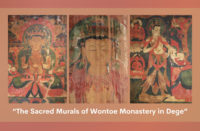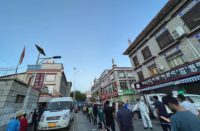
High Peaks Pure Earth presents an English translation of a blogpost by Woeser, originally written for the Mandarin service of Radio Free Asia on May 5, 2020 and published on her blog on May 8, 2020.
Woeser has long been documenting the changes in Lhasa, her 2013 blogpost alerted the wider world to the Chinese government’s 1.2 billion RMB project to “help preserve Lhasa’s ancient heart”. The article below reveals new pavilions being built in a Chinese style in front of the Jokhang Temple, Tibet’s holiest site. The pavilions are for historical steles, known as doring (rdo ring) in Tibetan.
The International Campaign for Tibet has expressed concern to the UNESCO World Heritage Center in Paris about the construction site and whether it affects the UNESCO-protected “Outstanding Universal Value” of the Jokhang Temple.
Please note this is the first of a two part essay, we will post the second part next week.
“Shocking: During the Epidemic, Two Chinese-Style Pavilions Appear in Front of the Jokhang Temple (Part 1)”
By Woeser
Already on January 27, as the Tibetan New Year was approaching, the local authorities announced the closure of all places that are usually swarmed with pilgrims and tourists, including the Jokhang Temple, Potala Palace and the Barkhor. No doubt, this was a necessary measure. Three months later, I saw a notice online issued by the Barkhor Old City Public Security Bureau: “On April 28, the Barkhor will re-open to Buddha groups and the general public.” The word “Buddha groups” was of course wrong; it should have read “Buddhist devotees.” But it had a somewhat dramatic character, as if all Buddhas were also going to get the opportunity to circumambulate the prayer paths.

The person who brought the epidemic to Tibet, or to say it more colloquially, that Zhang person from Wuhan who brought in the “poison from thousands of miles away” is known to almost all citizens of Lhasa. They were already discharged from hospital on February 13; subsequently, the TAR became a white spot on the epidemic map, with zero new infections. But is this true? The stories that spread among people in Lhasa are more worrying; they remind each other all the time that one cannot trust the official announcements.
With the infection rate being zero, the Barkhor area took the lead in opening up again to the public. But I still think that this was mainly done for the Labour Day holiday, which is a crucial time for the tourist industry. Tibet has become an immensely popular tourist destination. Especially after the “government construction group” turned the Barkhor and the Jokhang Temple into a scenic area called “Barkhor Old City” and thereby transformed it into a Disneyland for Chinese tourists, with not only souvenir shops, shopping centres and restaurants, but also all kinds of touristy performances. Before the outbreak of the epidemic, one could even see Chinese tourists dressed in the clothes of a late Qing Dynasty minister walking around the Barkhor, posing and taking selfies. This place has really become a stage on which tourists can engage in all kinds of vulgar performances.

On April 28, quite a few Tibetans actually went to circumambulate the Barkhor. After they got through several inspection points where their faces were scanned, temperature taken, masks checked, bags and ID inspected, they used their phones to take photos, which subsequently appeared online. The first thing, yes, the very first thing that caught one’s eye was a shocking new scenery. It seems that the epidemic has by no means stopped the determination and pace of the authorities’ attempt to transform everything. In front of Lhasa’s oldest and most sacred building- the Jokhang Temple – suddenly two pavilions under construction have appeared. Even though they are surrounded by propaganda slogans, from their overall appearance it becomes obvious that they are those kinds of pavilions that we find in any park anywhere across China. They are probably stele pavilions, because in the place where they are being built, we actually find three stone steles: the “Tang and Tibet Treaty Stele”, the “Smallpox Stele” and one more which is uninscribed. I am sure the local authorities will say that the pavilions are there to protect those steles. However, the two pavilions are far too massive, entirely obstructing the front facade of the Jokhang; also, they are built in a Chinese style and even though one can recognise a few Tibetan elements, they still seem utterly out of place; they are ugly and superfluous and completely destroy the traditional characteristics of the Jokhang Temple.

The “Tang and Tibet Treaty Stele” was put up in 823 AD, (according to documentation, it is an alliance treaty in Chinese and Tibetan that marks a border agreement between the Tang dynasty and Tibet, guaranteeing mutual respect and peace. Its most famous two sentences are: “And in order that this agreement establishing a great era when Tibetans shall be happy in Tibet and Chinese shall be happy in China shall never be changed, the Three Jewels, the body of saints, the sun and moon, planets and stars have been invoked as witnesses”, it can be seen as a warning to the two neighbouring countries to coexist peacefully). The “Smallpox Stele” was erected in 1794 by the Qing minister stationed in Tibet (indicating that Tibet is under formal care of the Qing court). The stele without inscription was probably put up by Tsongkhapa in 1409 following the repairing of the Jokhang Temple. Whether a thousand years ago, a hundred years ago or recently, there has never been a pavilion in front of Jokhang Temple; what is wrong with sun-bathing or bearing the hardships of rain, wind and frost together with this old architectural monument? Admittedly, from the point of view of heritage protection, it is necessary to take some measures, as the stele inscriptions have been significantly affected by erosion and are hardly recognisable. But building a Chinese-style pavilion does not mean heritage protection, right?! There would be other ways: for example, one could have produced a copy, moved the original into a museum and placed the copy in the original spot; this could be one way. Or if one did not want to move the original, one could have used new materials, like glass, to cover the steles, stabilise them, protect them from the sun and guarantee a stable temperature, but without changing its actual appearance; this could be another method. Why is it necessary to build such an eyesore? To prove that “it has been an inseparable part since ancient times”, a political propaganda statement that has been repeated tens of thousands of times?

These types of pavilions are not in accordance with Tibetan traditional building styles. In the old Lhasa, the only place where one finds two pavilions was on the western and eastern sides of Potala Palace, which Chinese documents call the “Monument to the Imperial Pacification of Tibet” and the “Ten Great Campaigns Stele”. The Manchurian army entered Tibet twice under the pretext of pacifying a war to fight the Mongolian Dzungar and expel them. During the Yongzheng period in 1724, they erected the stele in front of the Potala Palace; during the Qianlong period in 1792, a pavilion with glazed tiles was added. And in the manner of “buying one and getting one free,” they also put up a stele recording Emperor Qianlong’s ten great campaigns, also erecting a pavilion. These two pavilions don’t blend in with the local architecture, but thanks to the imposing and majestic Potala Palace with its lingka and parks, these two relatively tiny pavilions don’t really hurt the eye that much. For some reason, in 1965, when the CCP rebuilt Lhasa for the first time, they were moved to the Lukhang park behind the Potala Palace. While in the 1990s, during a second round of redevelopment, they were once again moved to the front of the Potala Palace.

What needs to be added is, if covering the steles in front of Jokhang Temple with pavilions is considered a form of heritage protection, well, why aren’t they also covering the steles at the Potala Palace with pavilions, wouldn’t that just be fair? But those two steles were put up by Tibetans themselves. Inside the palace, there is also one stele without inscription which was probably erected by the Fifth Dalai Lama after building the Potala Palace. From the lack of inscriptions we can see that Tibetans pay more attention to the construction of steles as a form of Buddhist worship; they do not attach great importance to tablets and steles with inscriptions, which is considered a matter of the laity. Chinese culture is different, it values steles and particularly pavilions, because they are afraid that otherwise their glorious achievements would be forgotten. The stele outside the Potala Palace was put up by Nganlam Takdra Lukhong, it is the earliest one in Tibetan. According to historical records, during the reign of the Tibetan king Trisong Detsen, the General Nganlam Takdra Lukhong built it below the Potala Palace to commemorate his merits as a soldier in Chang’an. On the northern eastern and southern side of the stele, we find inscriptions describing this historical period, including the fact that the Tang Dynasty would give Tibet 50,000 horses in exchange for the withdrawal of Tibetan soldiers. From a comparison of photos, we learn that the monument, also called the Lhasa Zhol Stele, was moved from the Potala Palace south gate on its western side to the north-eastern corner of the Potala Palace square and hereby cut off from the palace by the wide Beijing Middle Road. It was even sheltered by a high wall, so that it attracts no attention at all. The schemes of the government become manifest in every little detail, anything that does not agree with the empire’s facts and narrative will be transformed or even completely eradicated so that gradually, piece by piece, local history can be rewritten.
*Part Two to Follow*





Follow Us!